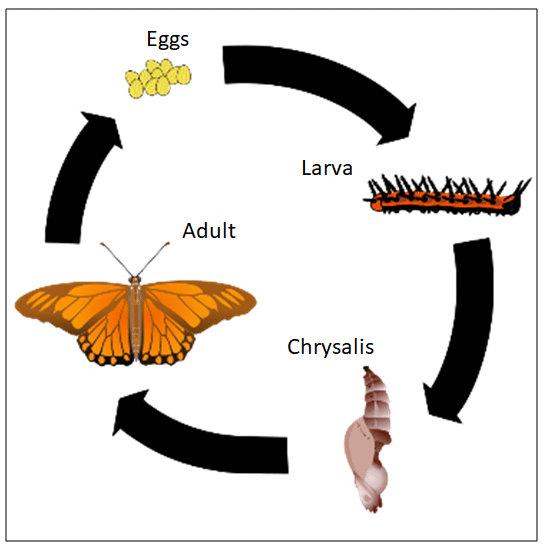Lifecycle of Living Things
Grade 8 Science Worksheets
Introduction
Living things go through a sequence of changes from one form to another and from one generation to another, in the process of growth and reproduction. Mammals, for example, develop from a fertilized egg to an adult. Adults then produce new sex cells, known as gametes, which fertilize new egg cells to initiate the same development process again. This specific and repeated pattern of developmental stages is called the Lifecycle of that organism. Life science shows that all plants and animals undergo a lifecycle unique to them. Two important lifecycles are explained here.
Schedule a Free session to clear worksheet doubts
No credit card required, no obligation to purchase.
Just schedule a FREE Sessions to meet a tutor and get help on any topic you want!
Plant Lifecycle
Flowering plants and trees start life as a seed which contains the embryo and a protective layer. A seed needs fertile soil to germinate by breaking the outer layer and growing roots, shoots, and leaves. This is the beginning of a new plant or tree, known as a seedling. When the plant has grown to maturity it grows flowers. Male flowers contain pollen and female flowers have ovaries. Natural elements, like the wind or bees, carry the pollen from one flower to the ovary of another flower and start the process of pollination. The cells in the ovary (ovules) are fertilized and new seeds are produced. These seeds get dispersed by wind, water, animals to new soil where the process of germination starts afresh.

Non-flowering plants (Gymnosperms), such as moss or fern, don’t produce seeds. They produce spores which get carried by the wind to new moist soil to begin life after germination.
Insect Lifecycle – Metamorphosis
Insects – houseflies, moths, butterflies – undergo transformation through strikingly distinct stages from an egg to adulthood. Typically, this is a four-stage process called a Metamorphosis.
- The egg
- The larva or caterpillar
- The pupa or chrysalis
- The adult
The lifecycle begins with the egg in which the embryo forms. These insects lay eggs on plants or on decaying organic matter which provides food for the next stage of development, called the larva. In butterflies and moths, the larva is also known as a caterpillar, while in houseflies it is referred to as a maggot. A larva is simply a fleshy worm-like creature, with or without hair, and with a sucking mouth. They have no wings.
The larva grows rapidly and sheds its outer skin many times, called molting, to reach the third stage in which it attaches itself to a twig and spins a cocoon around itself. This stage is known as the pupa or the chrysalis stage. The pupa may be silken in nature as with most moths and butterflies, or it may simply be a hard, protective shell as in the case of houseflies. Inside the chrysalis, a rapid and dramatic transformation takes place – the final metamorphosis!

Learn more about The Lifecycle of Living Things and other important topics with 8th Grade Science Tutoring at eTutorWorld. Our expert science tutors break down the topics through interactive one-to-one sessions. We also offer the advantage of customized lesson plans, flexible schedules and convenience of learning from home.
eTutorWorld Understands Math Tutoring | Online Math Worksheets are Important Tools
Understanding graphs, charts, and opinion polls in a newspaper, for calculating house and car payments, and for choosing a long-distance telephone service are impossible without strong math skills …and the only way to develop strong math skills is by constant practice.
‘Practice makes a man perfect’ holds true for no other field better than for math. A middle or high school student must set aside a minimum of an hour for math every day. Other than textbooks, worksheets help you revise and understand concepts better.
Our expert tutors prepare online maths worksheets that are age and grade-appropriate. Grade-wise math worksheets for Elementary Math, Arithmetic, Pre-Algebra, Algebra, Geometry, Trigonometry, Statistics, Pre-Calculus and Calculus can be solved to improve math skills, to get ahead or to even catch up.
You may download these FREE online math worksheets in the PDF format, and then print and email us their solutions for a free evaluation and analysis by eTutorworld’smath expert tutors.
You may solve these worksheets by yourself or with your peers while studying together.
The Answer Key at the end of each worksheet allows for a self-evaluation.
Personalized Online Tutoring
eTutorWorld offers affordable one-on-one live tutoring over the web for Grades K-12, Test Prep help for Standardized tests like SCAT, CogAT, MAP, SSAT, SAT, ACT, ISEE and AP. You may schedule online tutoring lessons at your personal scheduled times, all with a Money-Back Guarantee. The first one-on-one online tutoring lesson is always FREE, no purchase obligation, no credit card required.
For answers/solutions to any question or to learn concepts, take a FREE CLASS.
No credit card required, no obligation to purchase.
Just book a free class to meet a tutor and get help on any topic you want!
The larva or caterpillar grows wings, limbs, tissue, and all the beautiful colors of an adult butterfly or moth. It emerges by breaking the shell of the pupa and after resting awhile it slowly starts flapping its wings to become a fully developed adult. The adult then goes on to find a mate and repeats the process of laying eggs and having them fertilized to form a new lifecycle.

Check Point
- The process of growth and development from egg to adult in any living organism is known as its ______.
- Put in the correct order the flowering plant stages –
- Flowering
- Germination
- Seedling
- Pollination
- Non-flowering plants do not produce ______, they produce ______ instead.
- Put in the correct order the metamorphosis stages –
- Larva
- Adult
- Chrysalis
- Egg
- Other words for larva in butterflies and houseflies are ______ and ______ respectively.
Answer Key
- Lifecycle
- Germination, Seedling, Flowering, Pollination
- Seeds, Spores
- Egg, Larva, Chrysalis, Adult
- Caterpillar, Maggot
Schedule a Free session to clear worksheet doubts
No credit card required, no obligation to purchase.
Just schedule a FREE Sessions to meet a tutor and get help on any topic you want!
Pricing for Online Tutoring
| Tutoring Package | Validity | Grade (1-12), College |
|---|---|---|
| 5 sessions | 1 Month | $139 |
| 1 session | 1 Month | $28 |
| 10 sessions | 3 months | $269 |
| 15 sessions | 3 months | $399 |
| 20 sessions | 4 months | $499 |
| 50 sessions | 6 months | $1189 |
| 100 sessions | 12 months | $2249 |
8th Grade Free Worksheets
- The Universe
- Heredity
- Evolutionary Theory
- Structure of the atom
- Ethical Practices
- Unveiling the mystery behind the physical universe
- Components of the universe
- Celestial phenomena
- The tilt of Earth’s axis
- The causes of high and low tides
- Earth Systems
- Rocks and Fossils
- Weather and Climate
- Basics of chemical reactions
- Types of Chemical reactions – Endothermic, exothermic, oxidation, reduction reactions
- Catalysts and enzymes
- Compounds and mixtures
- Acids, Bases and pH Indicators
Images Credit:
https://upload.wikimedia.org/wikipedia/commons/thumb/d/d8/Gymnosperm_life_cycle_%28en%29.png/1127px-Gymnosperm_life_cycle_%28en%29.png
https://upload.wikimedia.org/wikipedia/commons/thumb/c/c1/Gulf_Fritillary_Life_Cycle.svg/922px-Gulf_Fritillary_Life_Cycle.svg.png
IN THE NEWS

Our mission is to provide high quality online tutoring services, using state of the art Internet technology, to school students worldwide.
Online test prep and practice
SCAT
SSAT
ISEE
PSAT
SAT
ACT
AP Exam
Science Tutoring
Physics Tutoring
Chemistry Tutoring
Biology Tutoring
Math Tutoring
Pre-Algebra Tutoring
Algebra Tutoring
Pre Calculus Tutoring
Calculus Tutoring
Geometry Tutoring
Trigonometry Tutoring
Statistics Tutoring
Quick links
Free Worksheets
Fact sheet
Sales Partner Opportunities
Parents
Passive Fundraising
Virtual Fundraising
Our Expert Tutors
Safe and Secure Tutoring
Interactive Online Tutoring
After School Tutoring
Elementary School Tutoring
Middle School Tutoring
High School Tutoring
Home Work Help
Math Tutors New York City
Press
©2022 eTutorWorld Terms of use Privacy Policy Site by Little Red Bird
©2022 eTutorWorld
Terms of use
Privacy Policy
Site by Little Red Bird






